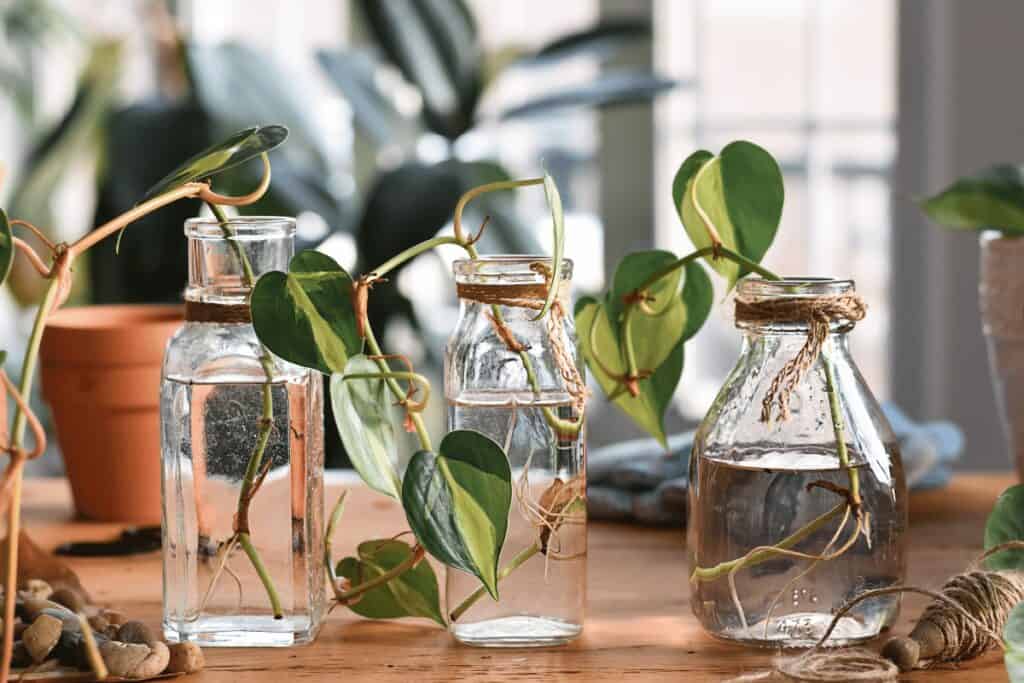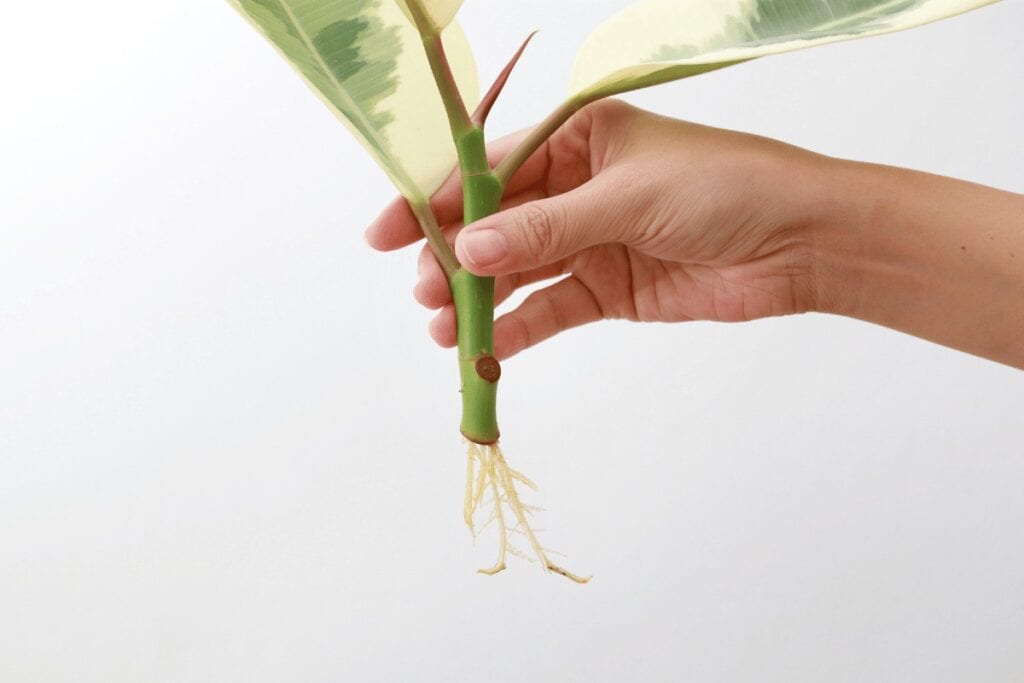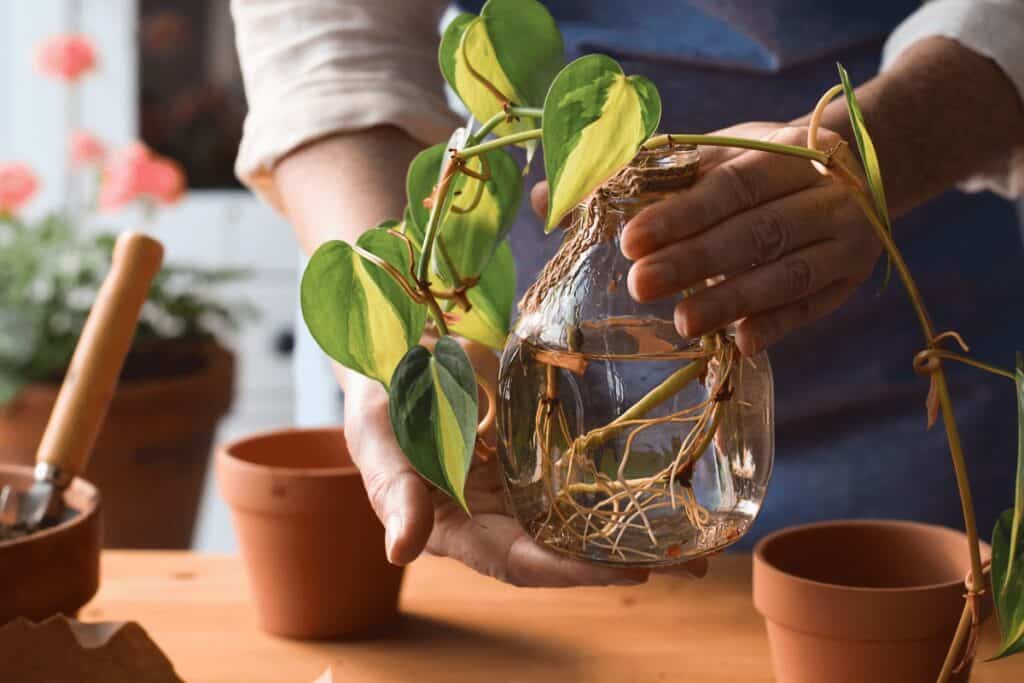Introduction ~ Do Cuttings Root Better in Water or Soil?
Growing new plants from cuttings is a cost-effective and rewarding way to expand your garden. However, deciding whether to root cuttings in water or soil can be a confusing process. In this blog post, Do cuttings root better in water or soil? we will explore the benefits and drawbacks of each method, as well as provide step-by-step instructions on how to root cuttings in the water and soilless mix.
By the end of this post, you will have a better understanding of which method is more effective for propagating plant cuttings.

Benefits and Drawbacks of Rooting Cuttings in Water
Drawbacks
- Cuttings may become waterlogged and rot [3]
- Plants may have difficulty transitioning from water to soil
Benefits and Drawbacks of Rooting Cuttings in Soilless Mix
Rooting in Water vs Soilless Mix

A. Advantages and Disadvantages of Each Method
When it comes to rooting cuttings, two common methods are rooting in water and rooting in a soilless mix. Each method has its own advantages and disadvantages.
Rooting in water is considered one of the easiest ways to grow new plants [2]. The process involves placing the cutting in a container of water until the roots grow. One advantage of this method is that you can easily see when roots have developed from the node of the cutting [1].
However, this method has a few drawbacks. Firstly, water can be a breeding ground for bacteria and fungi, which can cause rot and other diseases. Secondly, cuttings that are rooted in water may experience shock when transplanted into soil, as they are not accustomed to the different growing mediums [1].
On the other hand, rooting cuttings in soilless mix provides a cleaner medium and gives you more control [3]. Soilless mix drains well to provide oxygen to plants and is moist but not too wet to avoid root rot. Although some plant cuttings will root better in water, when rooting in soilless mix, cuttings develop a good root system and won’t experience shock when transplanted into soil after rooting in water [1].
Using soilless mix can be tricky, as it can be difficult to tell if the cuttings have rooted. In addition, some plants may not root well in soilless mix [3].
B. Factors that Affect Rooting Success
Several factors can affect the success of rooting cuttings in water or soilless mix. One important factor is the type of plant being propagated. Some plants may root better in water, while others may root better in soilless mix [1]. Another factor to consider is the time of year.
For example, rooting cuttings in water during the winter months may be more difficult due to lower temperatures [1]. Additionally, the length and diameter of the cutting can also affect rooting success [2].
In summary, both rooting in water and rooting in soilless mix have their advantages and disadvantages. While rooting in water is a straightforward method, it can be prone to rot and shock when transplanted into soil.
Rooting in soilless mix, on the other hand, provides a cleaner medium and gives more control, but can be tricky to tell if the cuttings have rooted. Several factors such as plant type, time of year, and cutting size can also affect rooting success.
Rooting Cuttings in Water
A. Best plants for water rooting
According to the Missouri Botanical Garden, many indoor houseplants such as begonias, coleus, polka-dot-plant, ivies, and philodendrons root easily in water. However, woody plants such as hibiscus and citrus do not root well in water and usually rot before rooting [3].
B. Step-by-step guide to rooting cuttings in water
To root a cutting in water, follow these steps:
Step 1
Take a cutting that is 4-6 inches long from the plant, cutting right above the node that connects the stem to the rest of the plant [1].
Step 2
Remove the lower leaves from the cutting so that only a few are left at the top.
Step 3
Fill a container with water and add rooting hormone if desired [2].
Step 4
Place the cutting in the water, making sure that the leaves are above the water line to prevent them from becoming waterlogged [2].
Step 5
Place the container in a warm, sunny spot and change the water every few days [2].
C. Tips for successful rooting
To ensure successful rooting, here are some tips:
- Choose healthy stems for cuttings and cut just above a node [1].
- Use clean shears or garden scissors to avoid spreading diseases to the plant [1].
- Make sure the container is clean to avoid contamination [2].
- Change the water every few days to keep it fresh and prevent rotting [2].
- Provide warmth and plenty of light to encourage root growth [2].
Rooting Cuttings in Soilless Mix
A. Recipe for the soilless mix:
A soilless mix is a great option for rooting cuttings because it provides a well-draining and oxygen-rich environment for delicate roots to grow. There are many recipes for a soilless mix, but here are some examples:
- 1 part topsoil (your own or store-bought)
- 1 part biotic matter (compost, leaf mold, coir, or peat moss)
- 1 part sand, perlite, or vermiculite (or a combination thereof)
- 1 part vermiculite
- 1 part sphagnum peat moss (note: not considered sustainable)
- Half sphagnum peat moss and half perlite or vermiculite
- 1 part peat moss or coco coir, 1 part perlite or coarse sand
B. Best plants for soilless mix rooting:
Many indoor houseplants, such as begonias, coleus, polka-dot-plant, ivies, and philodendrons root easily in a soilless mix. However, most herbaceous plants (non-woody plants) can be rooted in a soilless mix. On the other hand, woody plants such as hibiscus and citrus will not root well in a soilless mix.
C. Step-by-step guide to rooting cuttings in the soilless mix:
- Choose a healthy plant to take cuttings from.
- Cut a 4 to 6-inch long stem, just above the node where the leaves attach to the stem. Remove any lower leaves, leaving only the top two or three leaves.
- Dip the cut end of the stem in rooting hormone powder or gel.
- Fill a container with a soilless mix and moisten it.
- Make a hole in the soilless mix using a pencil or chopstick.
- Insert the cutting into the hole and gently press the mix around the stem to hold it in place.
- Water the soilless mix thoroughly and cover the container with a plastic bag or dome to create a humid environment.
- Place the container in a warm, bright spot, but out of direct sunlight.
- After a few weeks, gently tug on the cutting to see if it has rooted. If it resists, it has likely developed roots.
- Gradually remove the plastic bag or dome, and gradually expose the cutting to more light.
D. Tips for successful rooting:
- Use a sharp, clean-cutting tool.
- Choose a healthy plant to take cuttings from.
- Make sure the cutting has at least two or three leaves at the top.
- Use a rooting hormone to promote root development.
- Use a well-draining soilless mix to prevent waterlogged roots.
- Keep the soilless mix moist, but not waterlogged.
- Cover the container with a plastic bag or dome to create a humid environment.
- Place the container in a warm, bright spot, but out of direct sunlight.
- Be patient and don’t disturb the cutting while it’s rooting.
What Is Rooting Hormone?
Hormex Vitamin B1 Rooting Hormone Concentrate

Hormex Vitamin B1 Rooting Hormone Concentrate | Prevents Transplant Shock & Accelerates Growth for All Plants (32oz)
- Prevent Transplant Shock – Prevents transplant shock and stress from nutrient deficiencies and other environmental variables
- Improve Growth – Promotes deeper, stronger roots and stems while increasing foliage growth
- All Grow Mediums – Works with all plant varieties and grow mediums including hydroponic and aeroponics for accelerated growing success
- Healthier Plants – All plant varieties live longer when used regularly with your feeding program
Rooting hormone is a product that is used to stimulate root growth on plant cuttings. It is a synthetic chemical that mimics the natural plant hormone, auxin, which stimulates root growth. Rooting hormone is available in powder, liquid, or gel form [1].
The benefits of using rooting hormone are that it increases the chances of success when propagating plant cuttings. Rooting hormones contain synthetic auxins that stimulate the development of new roots, which can be especially useful when working with cuttings from difficult-to-root species.
Hormone rooting powders may also contain fungicides and other chemicals that reduce the risk of the cuttings succumbing to fungal infections [2]. In addition, rooting compounds can aid in rooting uniformity, accelerate root initiation, increase the number of roots produced, and reduce the time needed for successful rooting [3].
To use rooting hormone, first, make sure your cutting is clean and dry. Then, dip the cut end of the cutting into the rooting hormone powder or liquid, ensuring that the entire cut end is coated. Gently tap the cutting to remove any excess hormone powder.
Plant the cutting in a well-draining potting mix, water it thoroughly, and place it in a warm, bright location. Keep the cutting evenly moist and avoid exposing it to direct sunlight until new growth appears. It is important to follow the manufacturer’s instructions on the label when using rooting hormone products, as different types and concentrations require different application methods [1].
Caring for Rooted Cuttings

A. Transplanting rooted cuttings:
Once the cuttings have developed roots, they need to be transplanted into a pot or the ground. It’s best to wait until the roots are about 1-2 inches long before transplanting. According to [1], the cuttings should be cut at a 45-degree angle with a sharp knife or pruners.
Water the cuttings after inserting them into the medium, and cover them with plastic to create a humid environment. Place the container in indirect light and mist them regularly to keep the medium moist until the cuttings have rooted. Once the cuttings have been rooted, they can be transplanted into a pot or the ground.
To transplant rooted cuttings, gently remove them from the rooting medium, taking care not to damage the roots. According to a video by California Gardening on YouTube [3], it’s best to transplant the cuttings to a pot that’s slightly larger than the one they were in before.
Fill the pot with a good quality potting mix and make a hole in the center of the soil. Place the cutting in the hole and gently press the soil around the stem to hold it in place. Water the cutting immediately after transplanting and keep the soil moist.
B. Maintenance of rooted cuttings:
After transplanting, it’s important to maintain the right conditions to encourage the growth of the new plant. The cuttings need a humid environment and regular watering until they are established.
According to North Carolina State University Extension [2], cuttings should be kept in a location with bright, indirect light and temperatures between 65 and 75 degrees Fahrenheit. Mist the cuttings regularly to keep the soil moist and increase humidity around the plant.
As the plant grows, it may need to be repotted into a larger container or transplanted into the ground. Keep the soil moist but not waterlogged, and provide fertilizer as needed to encourage healthy growth.
Watch for signs of pests or diseases and treat them promptly to prevent damage to the plant. With proper care, your rooted cuttings should grow into healthy, thriving plants.
FAQS
What Is the Best Way to Root Plant Cuttings?
The two most common ways to root plant cuttings are in water and in soil. Some plants will root better in water, while others may root better in soil. For example, plants like coleus, spider plant, and pothos can root well in water, but the water method can cause the roots to be fragile and some plants resist rooting in water altogether [1]. On the other hand, some plants like rosemary can root well in soil, and a well-draining soil mix can help increase success rates [2].
How Do You Maximize Success in Cuttings?
To maximize success in cuttings, it is important to take cuttings from healthy parent plants, use a sharp knife or pruners to make a clean cut, and take cuttings from the newest growth on the plant. The cuttings should also be kept in a warm, humid environment with bright but indirect light. A rooting hormone can also be used to speed up the rooting process [1].
Can You Put Cuttings Straight Into the Water?
Yes, you can put cuttings straight into the water. However, not all plants will root well in water, and the roots can become fragile if left too long in water [3].
Can You Put Cuttings Straight Into the Soil?
Yes, you can put cuttings straight into the soil. However, a well-draining soil mix is important to increase success rates. The soil should also be moist but not too wet, and the cuttings should be kept in a warm, humid environment with bright but indirect light [2].
When Should I Transfer Cuttings from Water to Soil?
Once the roots reach around 3-5 inches, it’s time to transfer the cuttings from water to soil [3].
How Long Do Cuttings Take to Root in Soil?
The time it takes for cuttings to root in the soil varies depending on the type of plant and the conditions they are kept in. Generally, it can take several weeks to a few months for roots to form and the cutting to become established [2].
Why Do Cuttings Fail to Root?
There are several reasons why cuttings may fail to root, including taking cuttings from unhealthy plants, using dull cutting tools, placing cuttings in too much or too little light, not keeping the cuttings in a warm, humid environment, or not using a rooting hormone to stimulate root growth [1].
What Stimulates Root Formation in Stem Cuttings?
A rooting hormone can stimulate root formation in stem cuttings. Rooting hormones contain plant growth hormones that help stimulate the growth of roots on cuttings. Some plants may root without a rooting hormone, but using one can increase success rates [1].
Conclusion ~ Do Cuttings Root Better in Water or Soil?
Based on the information researched cuttings can root in both water and soil. However, rooting in a soil-less potting mix or perlite is recommended for better root development and drainage [2].
Cuttings rooted in water may develop tangly and stringy roots, which can be stressful for the plant if transplanted into the soil [3].
Additionally, standing water may lead to a lack of oxygen and minerals for the cuttings, negatively impacting their growth [3]. Although some easy-to-root plants may not require the use of rooting hormone, it can assure faster rooting for most cuttings [2].
Therefore, rooting cuttings in a soil-less potting mix or perlite with the use of rooting hormone may provide better results than rooting in water.




